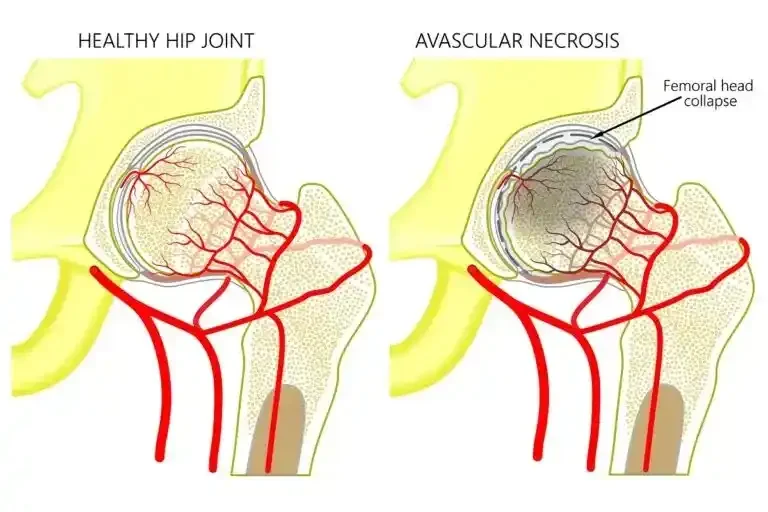Prior to 2020 had 1 or 2 cases visiting hospital OPD in a span of 6 months and now it is 12 in just four months.
Nashik: Just like heart and spine problems, there is a significant rise in the cases of Avascular Necrosis of the head femur in the younger population. Avascular Necrosis is a disease that leads to temporary or permanent loss of blood supply to the bones. Doctors have noticed an increased number of patients coming with complaints of AVN disease in their OPD.
AVN i.e Avascular Necrosis of the head of the femur is a disease of the hip joint which has recently been found rapidly increase incidence in the Covid pandemic, particularly in the younger population. “Prior to 2020, AVN, a disease of young (20-40) had 1 to 2 cases visiting hospital OPD in a period of 6 months. From April 2022 to August 2022, (4 months period), a total number of 12 patients were diagnosed to have Avascular Necrosis of the head of the femur. This suddenly increased incidence of AVN in pandemic may be related to Covid-19 virus or coagulopathy that follows after its infection,” said Dr. Pankaj Gunjal, Consultant Orthopaedic, Wockhardt Hospitals, Nashik.
Dr. Gunjal added, “Prior to 2020, AVN of the head femur was found in the young population, but it was not very common. Most of the time its causes were not identifiable, but certain diseases like sickle cell anemia, smoking, alcoholism, unmonitored, and long-term use of steroids were associated with AVN. After 2020, there was a sudden increase in patients with hip pain, and on the investigation, they are diagnosed with AVN of the head of the femur. From April 2022- August 2022, 12 patients were diagnosed with AVN of the head of the femur. Mostly, young patients came with back pain radiating to the lower limb. On careful examination, it is found that the pain they are complaining about is not from the back but from hip joints. Pain from the back usually radiates to the back of the lower limbs and can be felt till the foot while pain originating in the hip is felt on the front side of the thigh and radiates to the knee. Most patients are in the age group of 20-40, and males are more commonly affected. One particular complaint common in patients is pain while sitting on a bike in the initial stages of the disease.”
Four Stages of AVN (Avascular Necrosis)
AVN has 4 stages, in stage 1- mild pain is felt no changes are seen on X-ray, and MRI may show bone edema. In this stage, the blood supply to the head of the femur is stopped to a particular area and that area is necrosed (dead).” As the disease progresses in stage II, severe pain is felt, still, no changes are seen on the x-ray, MRI shows necrosis of part of the head of the femur with bone edema. In this stage due to the absence of blood supply, the particular part of the head of the femur has necrosed bone. The body makes an attempt to heal that area, and edema i.e inflammatory fluid increases in the head of the femur, which leads to severe pain in the hip joint. In stage 3, as the disease progresses, due to dead bone, the covering surface of the head collapses, there is severe pain and the patient feels pain in day-to-day activities and is unable to sit crossed-leg or squat. In stage 4, the irregular-shaped head has friction with its cup (acetabulum) and results in arthritis (wear and tear of joint) of the hip joints leading to decrease activities of patients due to severe pain,” highlighted Dr. Gunjal.
Timely treatment of AVN is the need of the hour. “Many patients don’t visit the hospital when the pain is mild and may take painkillers. In stage 2, pain is severe and a simple procedure that is core decompression can be done to reduce pain and avoid further damage to the joint, and delay arthritis. It is found that those diagnosed early with less than 30% of involvement of the head of the femur find greater benefits with this procedure. In stage 3/ 4, total hip replacement (THR) is the only option for complete relief from pain. In this operation, the joint is replaced by implants. Even lifestyle changes such as diet to reduce weight and exercises to strengthen the muscles around hip and core muscles should be done on a regular basis,” concluded Dr. Gunjal.
Dr. Pankaj Gunjal
Consultant: Joint Replacement & Orthopaedic Surgeries
Wockhardt Hospitals, Nashik
To book an appointment call: +918669998260
FAQs on AVN Among Youngsters
Q. What is the average age of AVN patients?
Ischemia that develops on a non-traumatic or traumatic background might result in AVN. Those between the ages of 20 and 40, who are physically active are usually the ones affected. Patients with avascular necrosis (AVN) typically fall within the age range of 30 to 50. However, the specific age may vary depending on the underlying cause and the joints affected. Younger individuals are equally susceptible to AVN, particularly if they have medical issues, use steroids, have experienced trauma, or possess other risk factors.












